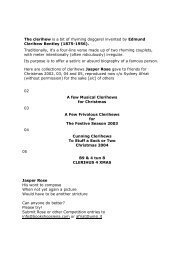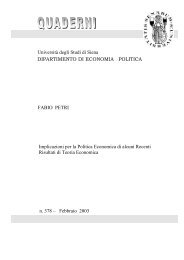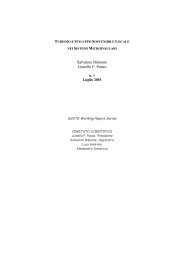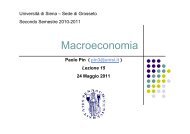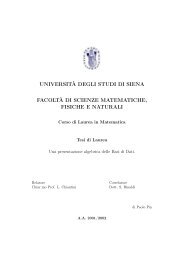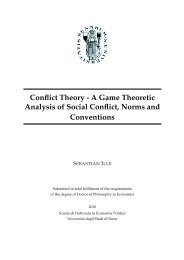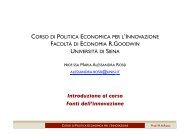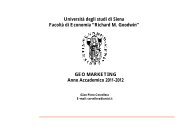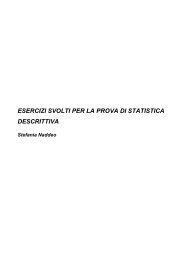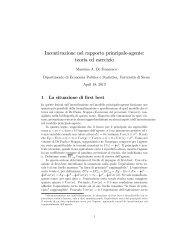Appunti delle lezioni di istituzioni di matematica attuariale per le ...
Appunti delle lezioni di istituzioni di matematica attuariale per le ...
Appunti delle lezioni di istituzioni di matematica attuariale per le ...
Create successful ePaper yourself
Turn your PDF publications into a flip-book with our unique Google optimized e-Paper software.
ischio è quin<strong>di</strong> il valore attua<strong>le</strong> <strong>attuaria<strong>le</strong></strong> in t della <strong>per</strong><strong>di</strong>ta che l’assicuratore subirà <strong>per</strong> il<br />
caso morte al tempo t + 1. La (152) quantifica quin<strong>di</strong> la parte del premio Pt che copre (in<br />
aspettativa) la <strong>per</strong><strong>di</strong>ta dell’assicuratore <strong>per</strong> il caso morte al tempo t + 1.<br />
Il secondo addendo della scomposizione è il premio <strong>di</strong> risparmio P S t .<br />
È quello che rimane<br />
del premio Pt dopo che è stata scorporata la componente <strong>di</strong> rischio; va a finanziare la prestazione<br />
anticipata caso vita in t, la prestazione posticipata caso vita in t + 1 e quel<strong>le</strong> (vita e<br />
morte) successive.<br />
La scomposizione (154) è particolarmente significativa <strong>per</strong> polizze a premio annuo, ma<br />
può essere effettuata anche <strong>per</strong> polizze a premio unico. In ta<strong>le</strong> caso, essendo nulli i premi<br />
successivi al primo, si avrà che premio <strong>di</strong> rischio e premio <strong>di</strong> risparmio sono uguali in valore<br />
assoluto ma <strong>di</strong> segno opposto.<br />
La notazione usata <strong>per</strong> in<strong>di</strong>care il premio <strong>di</strong> rischio e il premio <strong>di</strong> risparmio è quella della<br />
tra<strong>di</strong>zione <strong>attuaria<strong>le</strong></strong>; gli apici “R” e “S” sono <strong>le</strong> iniziali <strong>di</strong> “Risiko” (ted.: rischio) e “sparen”<br />
(ted.: risparmiare).<br />
Esempio 4.5.1. In una polizza temporanea caso morte a premio annuo (puro) P , con capita<strong>le</strong><br />
assicurato C, durata n anni, tasso tecnico i ed età alla stipula x, il premio <strong>di</strong> rischio e il<br />
premio <strong>di</strong> risparmio al tempo t assumono la forma<br />
P R t = C m <br />
t+1 − t+1Vx qx+t v= [C (1 − n−t−1Ax+t+1) + P n−t−1äx+t+1] qx+t v ,<br />
P S t = t+1Vx v − tVx =C (n−t−1Ax+t+1 v − n−tAx+t) − P (n−t−1äx+t+1 v − n−täx+t) .<br />
In questa tipologia contrattua<strong>le</strong> non ci sono capitali caso vita nel corso della durata della<br />
polizza che complicano la logica <strong>del<strong>le</strong></strong> espressioni. Il premio <strong>di</strong> rischio è il valore attua<strong>le</strong><br />
<strong>attuaria<strong>le</strong></strong> dell’integrazione <strong>di</strong> riserva che l’assicuratore deve o<strong>per</strong>are al tempo t+1 <strong>per</strong> pagare<br />
la prestazione caso morte. Il premio <strong>di</strong> risparmio va a incrementare la riserva in t + 1 <strong>per</strong><br />
finanziare <strong>le</strong> prestazioni successive: si ha infatti t+1Vx =<br />
(1 + i).<br />
tVx + P S t<br />
Esempio 4.5.2. In una polizza mista a premio annuo (puro) P , con capita<strong>le</strong> assicurato C,<br />
durata n anni, tasso tecnico i ed età alla stipula x, il premio <strong>di</strong> rischio e il premio <strong>di</strong> risparmio<br />
al tempo t assumono la forma<br />
P R t = C m <br />
t+1 − t+1Vx qx+t v<br />
= [C (1 − n−t−1Ex+t+1n−t−1Ax+t+1) + P n−t−1äx+t+1] qx+t v ,<br />
P S t = t+1Vx v − tVx<br />
= C (n−t−1Ex+t+1 v + n−t−1Ax+t+1 v − n−tEx+t − n−tAx+t)<br />
− P (n−t−1äx+t+1 v − n−täx+t) .<br />
Si osservi che <strong>per</strong> t = n − 1, la scomposizione dell’ultimo premio annuo fornisce Per t = n − 1,<br />
la scomposizione dell’ultimo premio annuo è<br />
P R n−1 = (C m n − nVx) qx+n−1 v = 0 ,<br />
P S n−1 = P − P R n−1<br />
= P ,<br />
che mostra come l’ultimo premio annuo sia tutto premio <strong>di</strong> risparmio.<br />
Esempio 4.5.3. In una ren<strong>di</strong>ta vitalizia imme<strong>di</strong>ata, posticipata e temporanea a premio annuo<br />
(puro) P , con rata della ren<strong>di</strong>ta R, durata n anni, tasso tecnico i ed età alla stipula x, il<br />
premio <strong>di</strong> rischio e il premio <strong>di</strong> risparmio al tempo t assumono la forma<br />
qx+t v = − [R (1 + n−t−1ax+t+1) − P n−t−1äx+t+1] qx+t v ,<br />
P R t = −C vp<br />
t+1 − t+1Vx<br />
P S t = t+1Vx v + C vp<br />
t+1 v − tVx = R (n−t−1ax+t+1 v − n−tax+t) − P (n−t−1äx+t+1 v − n−täx+t) .<br />
Il premio <strong>di</strong> rischio è negativo, <strong>per</strong>ché in caso <strong>di</strong> morte dell’assicurato al tempo t + 1 l’assicuratore<br />
ha un profitto in quanto omette <strong>di</strong> versare la rata e incamera la riserva.<br />
c○ C. Pacati 2005, <strong>Appunti</strong> IMAAV, sezione 4 (v. 13/12/2005) pag. 30



